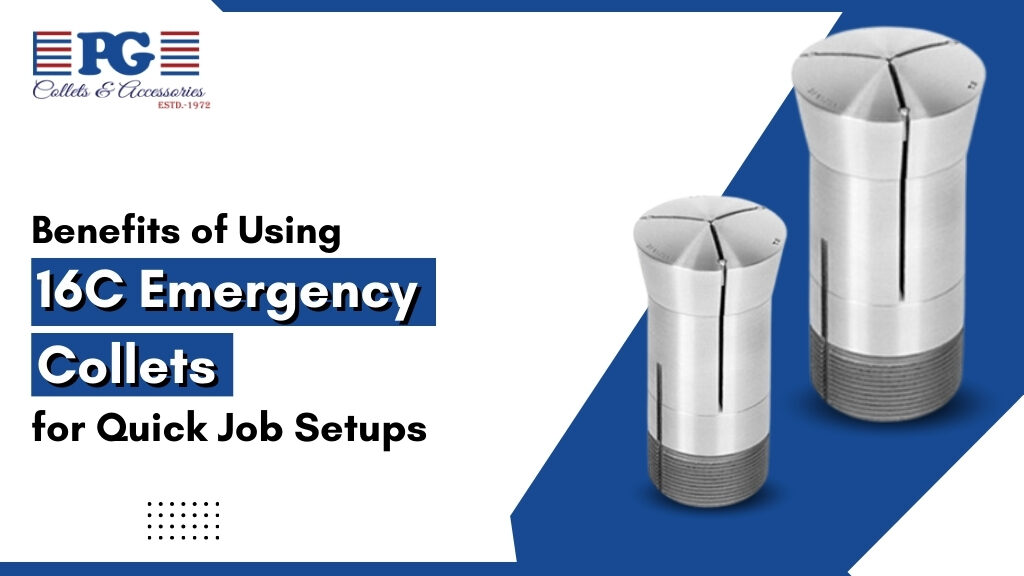PG Collets - Quality Collets Manufacturers and Exporters in India and Abroad

In the world of precision machining, efficiency and accuracy are paramount. One tool that has revolutionized the way machinists approach job setups is the 16C emergency collet. These versatile collets offer numerous benefits that make them indispensable for quick job setups. In this article, we’ll explore the key advantages of using 16C emergency collets, demonstrating why they are a must-have in any machinist’s toolkit.
A 16C emergency collet is a specialized tool used in lathes and CNC machines to hold workpieces securely. Unlike standard collets, emergency collets are designed to be machined to size, allowing them to accommodate custom diameters and shapes. This flexibility makes them ideal for rapid setups and unique machining tasks.
One of the primary benefits of 16C emergency collets is their versatility. Unlike standard collets that come in fixed sizes, emergency collets can be machined to fit specific dimensions. This feature is particularly useful for custom jobs where workpieces may not conform to standard sizes. By machining the collet to the exact diameter needed, machinists can ensure a perfect fit and secure hold.
Time is money in the machining industry. This collets enable quick job setups, reducing downtime and increasing productivity. Because these collets can be customized on the spot, there is no need to wait for special-order collets to arrive. This rapid adaptability is especially beneficial for small batch runs and prototype work, where flexibility and speed are crucial.
Investing in a set of 16C emergency collets can lead to significant cost savings. Since these collets can be machined to fit a wide range of sizes, there is no need to purchase an extensive inventory of standard collets. This reduces both initial investment and ongoing inventory costs. Additionally, the ability to reuse emergency collets for different jobs by re-machining them adds to their cost-effectiveness.
Precision is a critical factor in machining, and 16C emergency collets excel in this regard. By allowing for a custom fit, these collets minimize runout and ensure consistent, accurate machining. The secure grip provided by a well-fitted collet reduces the risk of workpiece slippage and vibration, leading to higher-quality finishes and more precise dimensions.
Using a properly fitted collet can extend the life of both the collet and the cutting tools. When a workpiece is securely held, there is less stress and wear on the cutting tools, which can result in longer tool life and reduced replacement costs. This not only saves money but also enhances overall efficiency by minimizing tool changeovers.
Safety is always a priority in any machining operation. 16C emergency collets contribute to a safer work environment by ensuring a secure hold on the workpiece. This reduces the risk of workpiece ejection and associated accidents. Additionally, the ability to customize the collet to fit irregular shapes and sizes helps prevent improper work holding, which can be a safety hazard.
Maintaining an extensive inventory of standard collets can be cumbersome and costly. 16C emergency collets simplify inventory management by reducing the need for multiple collet sizes. With a few emergency collets on hand, machinists can handle a wide variety of jobs, streamlining operations and reducing storage space requirements.
To fully leverage the benefits of 16C emergency collets, it’s important to understand how to use them effectively. Here are some steps to ensure optimal performance:
1: Select the Appropriate Collet
Choose a 16C emergency collet that is closest to the desired final diameter. This will minimize the amount of material that needs to be removed during machining.
2: Machine the Collet
Carefully machine the collet to the exact size required for the workpiece. This process involves boring out the collet to the desired diameter and, if necessary, creating custom profiles to accommodate unique workpiece shapes.
3: Install the Collet
Insert the machined collet into the collet chuck or spindle. Ensure that it is properly seated and secured.
4: Insert the Workpiece
Place the workpiece into the collet, making sure it fits snugly. Tighten the collet nut to secure the workpiece in place.
5: Begin Machining
With the workpiece securely held, proceed with the machining operation. Monitor the setup to ensure that the workpiece remains stable and secure throughout the process.
The benefits of using 16C emergency collets for quick job setups are clear. Their versatility, cost-effectiveness, and ability to improve workpiece accuracy and safety make them an invaluable tool in any machining operation. Whether for custom machining, small batch production, or repair work, 16C emergency collets offer the flexibility and precision needed to tackle any job with confidence.